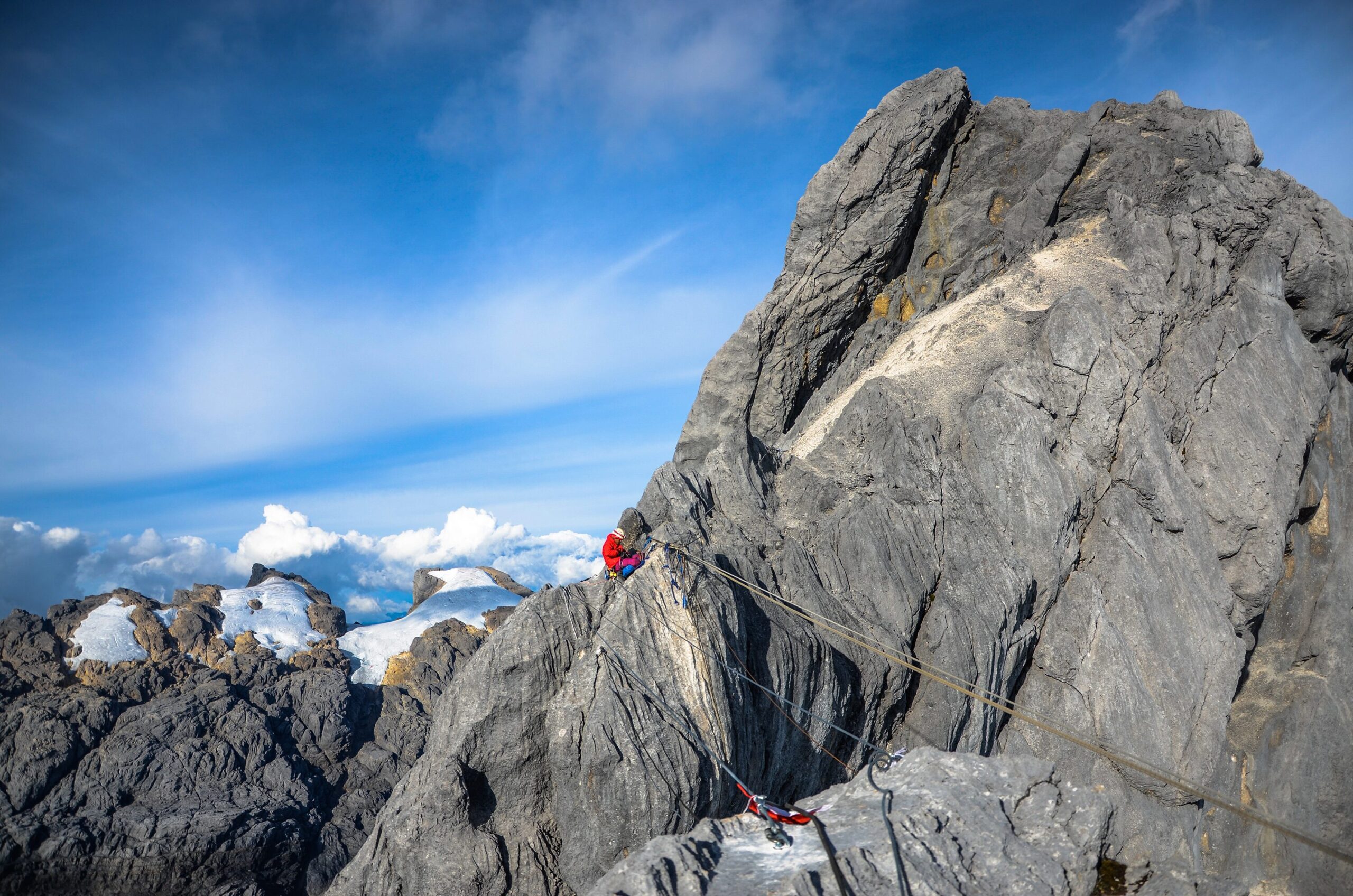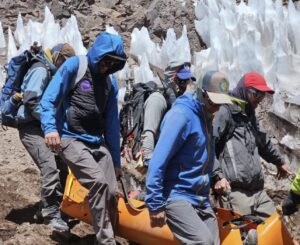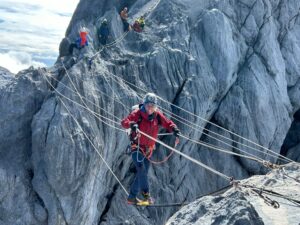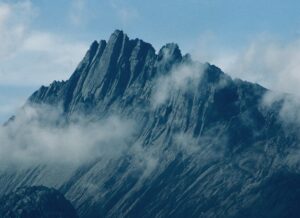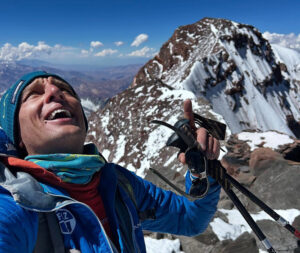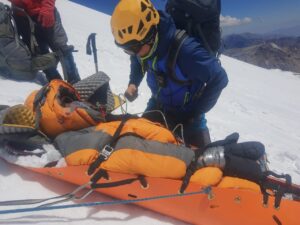For the first time in five years, Puncak Jaya, also known as Carstensz Pyramid, opened to international climbers this month for one month only. Those doing the Seven Summits seized the opportunity to flock to the Indonesian mountain. Many summited, but word soon spread about the death of a climber in a freak fall.
Conflict zone
Carstensz has been closed since 2019 because of a conflict in Western Papua between the Indonesian government and the rebels of the Free Papua movement. Because of this low-intensity guerrilla war, Indonesian authorities have restricted or forbidden foreigners from entering the area around the peak and its associated national park because of “safety and security concerns.”
Recently, the government announced it would open the park to foreign trekkers and climbers, but only during October. Not surprisingly, agencies hurriedly organized trips. Climbers working on their Seven Summits list dropped everything and signed up because there is no way to know when or if the peak will open again in the near future.

Base Camp at the foot of Puncak Jaya/Carstensz Pyramid.
Record hunters’ trophy
At 4,884m, Puncak Jaya (in Indonesian) or Carstensz Pyramid (after its Dutch discoverer) is one of the Seven Summits, along with the highest peaks in Europe (Elbrus in Russia), Asia (Everest in Nepal/Tibet), North America (Denali in the U.S.), South America (Aconcagua in Argentina), and Antarctica (Mt. Vinson). Carstensz, on the island of New Guinea, is the highest peak in Oceania, considered the seventh continent by some listers.
Another version of the Seven Summits uses Australia’s Mt. Kosciuszko instead. American businessman Dick Bass was the first to do the Kosciuszko version; Canadian mountaineer Pat Morrow was the first to do the Carstensz version. Kosciuszko is a walkup, while Carstensz involves real rock climbing.
The opening of Carstensz coincided with a time when several Nepalese professional climbers, mainly expedition company owners, are now adding the Seven Summits to their resumés. They have already completed the 14×8,000’ers.
So the Nepalese outfitters that we usually see in the Himalaya and Karakoram quickly assembled groups of clients and included the company owners. Seven Summit Treks was there along with its four founding siblings — check the Instagram post below. Also present, Imagine Nepal with Mingma G and Elite Exped with Nirmal Purja. There were also a number of other international teams and individuals who arranged their climbs with local agencies.
Guides in the area told ExplorersWeb that crowding was not a problem, since teams coordinated their respective pushes so that only about 15 climbers went for the summit each day. Once in Base Camp (at 4,250m), after either a five-day jungle trek or helicopter flight, Carstenz can be climbed in one 10-15 hour day. This relatively short round-trip time makes easy for climbers to spread out their summit pushes.
Most problems come from altitude or cold
Local outfitters insist on the need to acclimatize around Base Camp or get to the peak already acclimatized. Most incidents on Carstensz come from Acute Mountain Sickness or hypothermia since it can get very cold and windy on the upper sections.
Climbers start their summit push at around 2 am, so they can be back down before the nearly daily afternoon storms. The climb includes moderately technical sections on bare rock, which are well-secured with cables and ropes. One gap includes a Tyrolean traverse via cable.
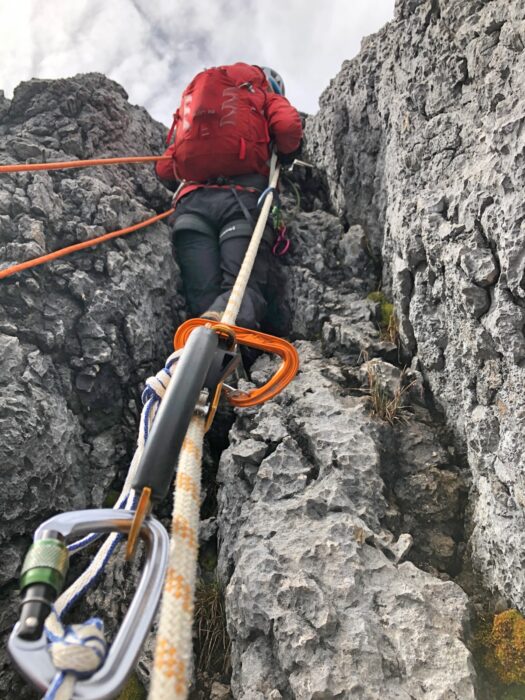
Climbing Carstensz Pyramid. Photo: Climbing The 7 Summits
The normal Harrer’s route on Carstensz goes up the north face. It climbs some 600 vertical meters up a series of cracks and gullies, a III-IV degree mix of scrambling and climbing, until the summit ridge. This is still far from the highest point.
The ridge traverse includes a crack that can be bypassed via the Tyrolean traverse mentioned above. The crux comes 80 vertical meters below the summit and is a 5+ UIAA degree climb on good limestone. A significant part of the way down requires rappelling. Guided expeditions usually achieve nearly 100% summit success.
At least two deaths
Yet the peak has taken at least two lives in the last few weeks. The first occurred before international expeditions even entered the national park. An Indonesian climber of Chinese descent, part of a local team, died on September 29, apparently of a heart attack.
The second death involved the fatal fall of a client on one of the Nepal-based teams: Imagine Nepal.
Freak fall
The team had flown to Base Camp one day earlier. All members were experienced in high-altitude climbing. The deceased climber, Mr. Dong Fei of China, had previously climbed Ama Dablam, which involves high altitude and technical sections.
Dong, accompanied by a local guide, summited almost 40 minutes ahead of the rest of the group. He waited for them on top, then started down ahead of the others with the guide,” Imagine Nepal told ExplorersWeb. The group learned about the fall when they reached the Tyrolean traverse on their way back.

The Tyrolean traverse near the summit of Carstensz Pyramid. Photo: Summitcarstensz
Apparently, the climber made a lethal mistake. “There were three ropes in a rappel section, and one was cut off. For some reason, it looks like he caught a shorter rope,” sources from Imagine Nepal said. “Later, we asked the local guide, and he said he helped Mr. Dong descend with an Italian hitch [a friction knot used from a belay to control the descent of another climber]. But he [Dong] refused to use a descending device and chose to go down by just holding the rope.”
Beyond help

The probable spot where the accident took place.
According to Imagine Nepal, the expedition leader said that he immediately ran to the spot of the accident and found the climber unconscious. He performed CPR until the injured climber breathed again and prepared to descend by rope to an emergency camp on a flatter section of the mountain. However, the injured climber was bleeding heavily from his left ear, which made the rescuers fear the worst.
One of the local guides and the expedition leader brought the man slowly down to the emergency camp. But just a few meters from the tent, he stopped breathing. The next day, a helicopter flew the body back to Base Camp.
One of the guides on the mountain reported that there was also another deceased climber. So far, we have not found confirmation about this third fatality.
